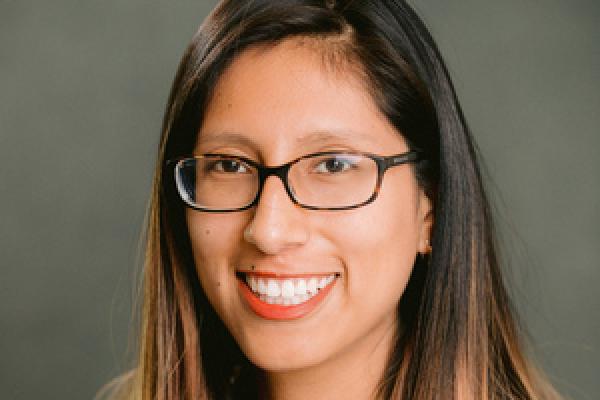OSU Physics Alumni Daniella Roberts Featured in APS 'Physics Today'

From original article, "Persistence pays off for APS Bridge Program graduate, now aviation data scientist", for APS News by Kendra Redmond
"As a kid, Daniella Roberts learned all she could about the moon, stars, and planets from Microsoft Encarta, a now-discontinued digital encyclopedia, and the night sky — although it was tricky to use her telescope from the family’s apartment window in Quito, Ecuador.
Now a Ph.D. physicist with expertise in satellite galaxies, Roberts knows how entwined physics and astronomy are. But when she first took physics in tenth grade, she wasn’t enamored. She thought the subject was too math-heavy and overly complicated. “I actually hated it,” she says.
Her road from loathing physics to her current role — using her physics Ph.D. to identify aviation safety risks for the Federal Aviation Administration — was paved with resolve. Roberts credits the support of her parents, advisors, and the APS Bridge Program, which provides an alternate pathway to graduate school for minority students, for helping her realize her goals.
The first inflection point came in Physics II, a required class in Ecuador’s high schools. “That teacher made me fall in love with the subject,” Roberts says. She loved it so much that, after her family moved to Miami, Roberts took physics again her senior year, just for fun. This time, her teacher was a woman. “I thought that was so cool,” Roberts says. She wanted to be a veterinarian but, for the first time, could picture herself as a physicist.
A poster adorning her physics classroom highlighted the many professions open to people who study the subject. Intrigued, she entered Florida International University as a physics major preparing for vet school — which meant taking lots of chemistry alongside physics. After a while, facing the reality of just how much chemistry she would need for vet school, Roberts decided to instead see where physics took her.
At FIU, she immersed herself in classes and in astronomy research with Professor James Webb. She got involved with the Stocker AstroScience Observatory being built on campus, learning to use the 24-inch telescope, teaching groups of students to observe, and hosting “star parties” with the astronomy club. As she neared graduation, Roberts realized she wasn’t ready to drop her focus on learning. Graduate school it was.
Roberts applied to several graduate programs and was devastated when she wasn’t accepted. “That was seriously heartbreaking for me,” she says. Studying for and taking the GRE had been difficult, and it hit hard that after so much effort, she hadn’t made the cut. But Roberts didn’t give up.
At the urging of one of her professors, she applied to the APS Bridge Program and was offered a one-year trial in the Ohio State University’s program. If she did well, OSU would consider admitting her to their bridge program the following year. Roberts went all in and spent the year as an unofficial member of OSU’s Bridge Program cohort. The next year, she received offers from two bridge programs, including OSU. “I was very, very happy,” she says. She decided to stay where she was.
“For me, the shift between undergraduate and graduate school was really big,” she says. “I’m glad I had that extra year.” Being part of the Bridge Program came with several benefits, including having a supportive, collaborative cohort; being paired with her research advisor, Annika Peter, right from the start; and not needing to be a teaching assistant the first few years, Roberts says.
In 2022, Roberts graduated from OSU with a Ph.D. in physics. She is now a data scientist at the nonprofit corporation MITRE, which operates research and development centers on behalf of government agencies. She works with huge datasets from airports and flight tracking programs to identify and address safety concerns in the National Airspace System. That often involves cleaning up datasets, which can be like putting puzzle pieces together, Roberts says. Only when datasets are reliable, formatted correctly, and properly interfacing with one another can she begin the analysis.
Aviation safety might seem far removed from the subject of her thesis — identifying satellite galaxies, smaller galaxies that orbit around more massive galaxies and can reveal information about the evolution of the universe — but there are many parallels. Both rely heavily on data analysis, coding, developing evidence-based findings, and effectively communicating with others.
In research, Roberts says, you can’t just put up a plot and say, “Here’s my answer.” You have to explain why you made that plot and why it’s important. Although she works with different data sets now, the process is similar. “I get data and I present it to my group and say, ‘Hey, this is what I think it's saying. This is why I think it's saying this.’”
During graduate school, Roberts came to appreciate the collaborative process so much that she sought positions that relied on it. MITRE is a great fit, she says. In her current role, she works with other data scientists, software engineers, statisticians, and additional technical experts.
To students considering graduate school, Roberts says to surround yourself with people you trust and who support your persistence. “If you really do want to go to grad school, don't give up,” she says. “If this is a dream of yours, you can do this.”
You can read the original article on the APS website.
